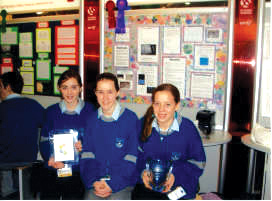| 2006 |

|
YEAR BOOK |
Colaiste Choilm, Ballincollig, Co Cork
|
The maths of bubbles
|

� D and 3D frames
� Bubble distribution
� Light and bubbles
� Angles that bubbles form
� Motorway problemWe built a cube and a tetrahedron. We composed a graph that shows the relationship between the inner bubble and the outer frame. Our graph proves that as the volume of the inner bubble increases the ratio of the volume of the inner bubble increases accordingly. The formula we used is x3/1000cm 3 with x3 being the volume of the bubble and 1000cm 3 being the volume of the outer frame.
We found the distribution area of a bubble structure by finding the area of each bubble in our sample. We found that the average area of our bubble distribution to be 159.96 boxes of graph paper squared.
We studied the interference of light and bubbles by shining a laser through the bubble film. We used Snell's Law to find the angle of refraction in our experiments.
We created different bubble shapes by amalgamating bubbles together and measured every angle formed. We proved that bubbles always form 120 degree angles and the average number of sides on a 2D structure is six.
Plateau's Motorway Problem tries to find the shortest way of connecting four points. We built a frame with four points A,B,C,D. Since bubbles always form the smallest possible surface area (e.g a sphere) we used bubbles to find the shortest way of connecting the points. Using the distance formula we measured seven possible routes that may form. Our estimate no 7 had the shortest distance 27.32 cm. The bubbles in our frame formed exactly like our estimate no 7. We then knew that we were correct in saying it was the shortest possible connection because our practical experiment proved our mathematical evidence.
We won the Intermediate Maths, Physics and Chemistry Category and we recieved a Special Physics Award from the Institute of Physics. We would strongly advise students to enter the Bt Young Scientist as it was a very memorable experience and was a great opportunity for us to expand our knowledge on science.
We would like to thank Mr Liam O'Callanain, Ms Fiona O'Sullivan and the Institute of Physics for all the opportunites it has opened up for us.
Jennifer Martin, Orla Murphy & Katie O'Donovan, entered their project in the Intermediate Group Section of the Chemical, Physical & Mathematical Sciences Category at the BT Young Scientist & Technology Exhibition in January 2006. They were winners of of this category and also recieved a special Award sponsored by the Institute of Physics. Their teacher was Ms Fiona O'Sullivan.
| This article was sponsored by the Institute of Physics. |
|---|